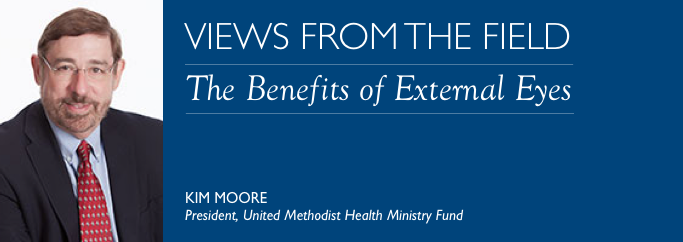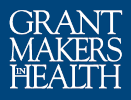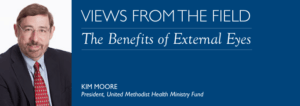
How is our work going, really? Can staff answer that question with a sufficient degree of critical appraisal? Can we rely on the complete honesty of funded partners, who are thrilled that we have recognized their causes as ours, to gain a sense of our impact? Is our board prepared, engaged and yet distant enough to provide a wise response to this fundamental question of success? Leadership at United Methodist Health Ministry Fund did not feel that a sufficiently helpful answer could be secured from these sources—and the question is one which merits an informed answer.
In early 2016, we turned to Grantmakers In Health (GIH) to bring external eyes to our work to answer three specific questions deemed critical to our current and future directions:
- Are program areas appropriately focused, potentially productive, and making the right connections for impact?
- Do we have the right staff for our work and what traits should be considered in recruiting a new president?
- Are we positioned to do more intermediary work (i.e., securing outside funding and managing re-granting programs)? Are we staffed for this work? What are likely productive approaches for this work?
GIH had piloted a redesigned peer review process with the Phoenixville Community Health Foundation in 2015. That experience was used by GIH and the Health Ministry Fund to plan for a very similar review process for our 29-year-old organization, which is anticipating its first ever leadership change at the end of 2017. GIH staffer Eileen Salinsky assembled a team of three exceptional foundation leaders, who consulted with us at every step of the selection process. We opted for leaders from out of state organizations similar in size and scope to the Health Ministry Fund. We also wanted persons with experience in intermediary work. Pat Baker, President, Connecticut Health Foundation; Gary Nelson, President, Healthcare Georgia Foundation; and Susan Zepeda, immediate past President of Foundation for a Healthy Kentucky, graciously volunteered for the work and joined Eileen for a two-day visit to Hutchinson, Kansas. The sun is always shining in Kansas, as our Governor is fond of saying, and there was plenty of July sunshine to welcome the team.
Prior to the visit, we inundated the team with board minutes, policies, strategic documents, program descriptions, financial information, publications, and specially prepared analyses. We explained our three grant program areas—breastfeeding, rural health systems, and young children’s behavioral health—and the Healthy Congregations program, which we operate directly. The visit was organized into interviews with foundation staff; board members; four groups of grantees, field leaders and advocates; and colleagues in Kansas health philanthropy. I had dinner with the team and an opportunity for an “exit” interview to gain their immediate impressions. After the visit, Eileen coordinated development of a written report, and Susan and Eileen returned to Kansas to make an oral presentation of the results to our board at its September strategic planning retreat. This report and the conversation it engendered formed the first half of our board retreat work. With the encouragement of our board, staff are implementing several of the ideas and answering questions raised by the team.
Our three program areas are at very different stages of development—one is approaching its conclusion, while the other two still gaining traction. We are in the process of refining the theories of change for the latter two and developing new strategies for movement into the next levels of activity. The peer review team’s conversations with focus groups underscored just how critical it is for us to explicitly and clearly communicate our goals and visions for change to our partners. We are at a point in program development where new energy needs to be given to this activity. We are also considering how to make rural health an overall frame for our work, in part because rural health was identified as an area where we are seen as having particular potential to lead and a very natural affinity due to our location.
Within our context of an upcoming change in Health Fund presidential leadership, appropriate transitional activities need to be undertaken to transfer relationships, experiences, and historical learnings. Documentation of processes, procedures, staff responsibilities, and workflow is important. Maintaining the right level of support for the board and staff during this process is a responsibility which starts now—almost a year out. Involving the Health Fund’s larger community of interest in the search process will be critical; we have already taken the step of broadening the search committee with former board members. I have become more intentional and active in my role in this transition, rebalancing my strong belief that the search and decision are the board’s responsibility with my opportunity to provide a well-prepared organization for the new leader.
Our relatively recent foray into intermediary work was high on our list of topics for review by the team. They affirmed our goal to undertake only intermediary work which furthers our strategic program areas. We know this is something to monitor carefully as the attractiveness of money for a grantmaker intermediary can become as much of a lure as are available grants for the typical nonprofit grantseeker. We will likely continue to see much of our collaborative work carried out through the association of six Kansas health philanthropies, Kansas Grantmakers in Health, where we are able to participate meaningfully in larger projects. We will also remain on the lookout for other mission-aligned opportunities permitting us to marshal resources to conduct more investment at the scale necessary for success.
Beyond the specific recommendations and responses provided by the visiting team’s final report, there are several intrinsic benefits to participating in a peer review process. The interactions of this team with our board, grantees, and other associates led to conversations in which staff has learned important information and improved connections. We believe the openness fostered by the peer review process has assisted some constituencies to be more transparent with us. While one always pays more attention to those comments which might have some slight negative judgment, the main effect of the review increased confidence in our overall approaches and encouragement for future opportunities.
If your organization is at a particular crossroads or has not undergone a 360-degree assessment recently, consider giving GIH a call to learn more about the peer review process. We found the process to have enough flexibility to gain what we needed from it and to be valuable for our organization and our network. In addition to the ideas we are implementing that were generated by the peer review process, the learning that our staff received has improved our own ability to see and express how we are doing. That is the result of external eyes looking inside your philanthropic operation and providing honest appraisal.

